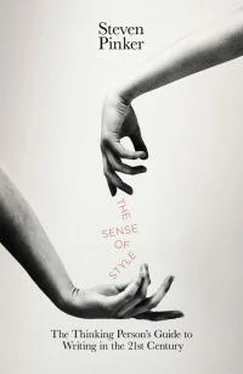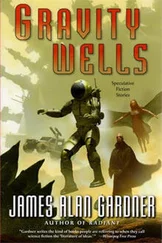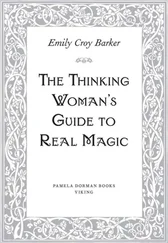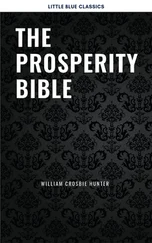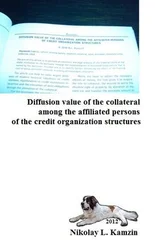The problem for the writer is that punctuation indicates prosody in some places, syntax in others, and neither of them consistently anywhere. After centuries of chaos, the rules of punctuation began to settle down only a bit more than a century ago, and even today the rules differ on the two sides of the Atlantic and from one publication to another. The rules, moreover, are subject to changes in fashion, including an ongoing trend to reduce all punctuation to the bare minimum. They fill scores of pages in reference manuals, and no one but a professional copy editor knows them all. Even the sticklers can’t agree on how to stickle. In 2003 the journalist Lynne Truss published the unlikely bestseller Eats, Shoots & Leaves: The Zero Tolerance Approach to Punctuation (whose title comes from the punch line of a joke about a panda who shot up a restaurant because he had read a mispunctuated description of his dietary habits). In her book Truss decries the punctuation errors she spotted in ads, signs, and newspapers. In a 2004 New Yorker review, the critic Louis Menand decries the punctuation errors he spotted in Truss’s book. In a Guardian article on the response to Truss, the English scholar John Mullan decries the punctuation flaws he spotted in Menand’s review. 59
Still, a few common errors are so uncontroversial—the run-on sentence, the comma splice, the grocer’s apostrophe, the comma between subject and predicate, the possessive it’s —that they have become tantamount to the confession “I am illiterate,” and no writer should be caught making them. As I mentioned, the problem with these errors is not that they betray an absence of logical thinking but that they betray a history of inattention to the printed page. In the hope that an ability to distinguish the logical and illogical features of punctuation may help a reader master both, I’ll say a few words about the design of the system, highlighting the major bugs that have been locked into it.
commas and other connectors (colons, semicolons, and dashes). The first of the comma’s two major functions is to separate parenthetical comments about an event or a state—the time, place, manner, purpose, result, significance, writer’s opinion, and other by-the-way remarks—from the words that are necessary to pin down the event or state itself. We already met this function in the distinction between restrictive and nonrestrictive relative clauses. A restrictive relative clause, such as the one in Sticklers who don’t understand the conventions of punctuation shouldn’t criticize errors by others, is free of commas, and thereby singles out a subset of sticklers, namely those who don’t understand the conventions of punctuation. The same phrase set off by commas, Sticklers, who don’t understand the conventions of punctuation, shouldn’t criticize errors by others, slips in a snide comment on the competence of a typical stickler, but that jibe is irrelevant to the advice conveyed by the sentence, which is offered to sticklers across the board.
The traditional terms “restrictive” and “nonrestrictive” are misnomers, because the comma-less versions (called “integrated relative clauses” by the Cambridge Grammar ) don’t always restrict the referents of the noun to some subset. What they do is specify information that is necessary to make the sentence true. In the sentence Barbara has two sons whom she can rely on and hence is not unduly worried, the underlined relative clause does not pare down the set of Barbara’s sons from the full brood to just the two she can rely on; she may only have two. It indicates that because those two sons are sons on whom Barbara can rely, therefore she has no need to worry. 60
And that is a key to understanding where to put commas in other constructions. Commas set off a phrase that is not an integral constituent of the sentence, and which as a result is not essential to understanding its meaning. The sentence Susan visited her friend Teresa tells us that it’s important for us to know that Susan singled out Teresa as the person she intended to visit. In Susan visited her friend, Teresa, it’s only significant that Susan visited a friend (oh, and by the way, the friend’s name is Teresa). In the headline NATIONAL ZOO PANDA GIVES BIRTH TO 2ND, STILLBORN CUB, the comma between the two modifiers indicates that the panda gave birth to a second cub and (here’s another fact) the cub was stillborn. Without the comma, the stillborn would be embedded beneath the 2nd in the tree, and the meaning would be that this is the second time she has given birth to a stillborn cub. Strings of modifiers without commas progressively narrow down the referent of a noun, like nested circles in a Venn diagram, whereas strings of modifiers with commas just keep adding interesting facts about it, like overlapping circles. If the phrase had been 2nd, stillborn, male cub we would now know one more fact about the dead offspring, namely that it was male. If it had been 2nd stillborn male cub we would know that the previous stillborn cub was male, too.
This doesn’t sound all that hard. So why are there so many comma errors out there for the zero-tolerance squad to get incensed about? Why do comma errors account for more than a quarter of all language errors in student papers, occurring at a rate of about four errors per paper? 61The main reason is that a comma does not just signal a syntactic break (marking a phrase that is not integrated into a larger phrase) together with the corresponding semantic break (marking a meaning that is not essential to the meaning of the sentence). It also signals a prosodic break: a slight pause in pronunciation. Now, often these breaks line up: a supplementary phrase, the kind that calls for a comma, is typically preceded and followed by a pause. But often they do not line up, and that lays out a minefield for an inexperienced or inattentive writer.
When a supplementary phrase is short a speaker naturally skates right over it to the next phrase in the sentence, and the current rules of punctuation give writers the option of going with the sound and leaving out the commas—as I did just now, omitting the comma after short . The rationale is that too many commas too close together can give a sentence a herky-jerky feel. Also, since a sentence may have many levels of branching while English provides only the puny comma to separate them all on the page, a writer may choose to keep the comma in reserve to demarcate the major branches in the tree, rather than dicing the sentence into many small pieces that the reader must then reassemble. The reason I refrained from inserting a comma after When a supplementary phrase is short was that I wanted the comma between the end of that clause and the beginning of the next one to neatly cleave the sentence in two. The cleft would have been obscured if the first clause had also been riven by a comma. Here are some other sentences in which the comma may be omitted, at least in a “light” or “open” punctuation style, because the following phrase is short and clear enough not to require a pause before it:
Man plans and God laughs.
If you lived here you’d be home by now.
By the time I get to Phoenix she’ll be rising.
Einstein he’s not.
But it’s all right now; in fact it’s a gas!
Frankly my dear, I don’t give a damn.
That is the choice that Lynne Truss made in the dedication to Eats, Shoots & Leaves:
To the memory of the striking Bolshevik printers of St Petersburg who, in 1905, demanded to be paid the same rate for punctuation marks as for letters, and thereby directly precipitated the first Russian Revolution.
Читать дальше
